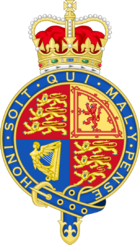Flags and Emblems (Display) Act (Northern Ireland) 1954 facts for kids

|
|
| Long title | An Act to make provision with respect to the display of certain flags and emblems. |
|---|---|
| Citation | 1954 c. 10 |
| Dates | |
| Royal assent | 6 April 1954 |
| Commencement | 6 April 1954 |
| Repealed | 1 April 1987 |
| Other legislation | |
| Repealed by | Public Order (Northern Ireland) Order 1987 |
| Relates to | Civil Authorities (Special Powers) Act (Northern Ireland) 1922, Public Order Act (Northern Ireland) 1951 |
|
Status: Repealed
|
|
The Flags and Emblems (Display) Act (Northern Ireland) 1954 was a law passed in 1954 by the Parliament of Northern Ireland. This law was later cancelled in 1987 by the British government during a time called direct rule.
This Act was very unpopular with people who supported Irish nationalist ideas. They felt the law was made to stop them from showing their identity. The law did not directly name the Irish tricolour (Ireland's flag). However, it gave the police, known as the Royal Ulster Constabulary, the power to remove any flag or symbol from public or private places if they thought it might cause trouble or a fight.
The important part was that the Union Flag (the flag of the United Kingdom) was always safe. It could never be seen as causing trouble under this law. This meant that almost any flag other than the Union Flag could be removed, especially the Irish tricolour. Still, the law was not a complete ban. The Irish flag was sometimes allowed to fly, especially at places like GAA sports grounds.
Contents
Why the Law Was Made
Political Tensions in Northern Ireland
The Flags and Emblems Act was created during a difficult time in Northern Ireland. There was a lot of disagreement among people who supported unionism. Unionists wanted Northern Ireland to stay part of the United Kingdom. The government, which was mostly made up of Ulster Unionists, was worried about these disagreements.
Rising Flag Displays
Some unionists felt the government was being too soft on nationalists. When the government allowed some nationalist parades, more Irish tricolours started appearing. This made some unionists upset.
Coronation Celebrations and Disputes
Around the same time, there were big celebrations for the Coronation of Queen Elizabeth II. Union Flags were put up everywhere, not just in areas where unionists lived. They also appeared in nationalist areas. This led to arguments, and sometimes Union Flags were taken down and replaced with Irish tricolours. Nationalists also refused to shop at stores that openly displayed the Union Flag for the coronation. This made tensions higher and increased fears among unionists. The new Act aimed to control these flag displays and reduce conflict.
Consequences of Breaking the Law
If someone broke this law, they could face serious penalties. The Act gave the police more power, similar to some powers from an older law called the Civil Authorities (Special Powers) Act (Northern Ireland) 1922.
Famous Incidents and Riots
Sometimes, trying to enforce this law led to big problems. One of the most well-known events happened during the UK General Election in 1964. This took place on the lower Falls Road in Belfast, where enforcing the Act caused riots.

